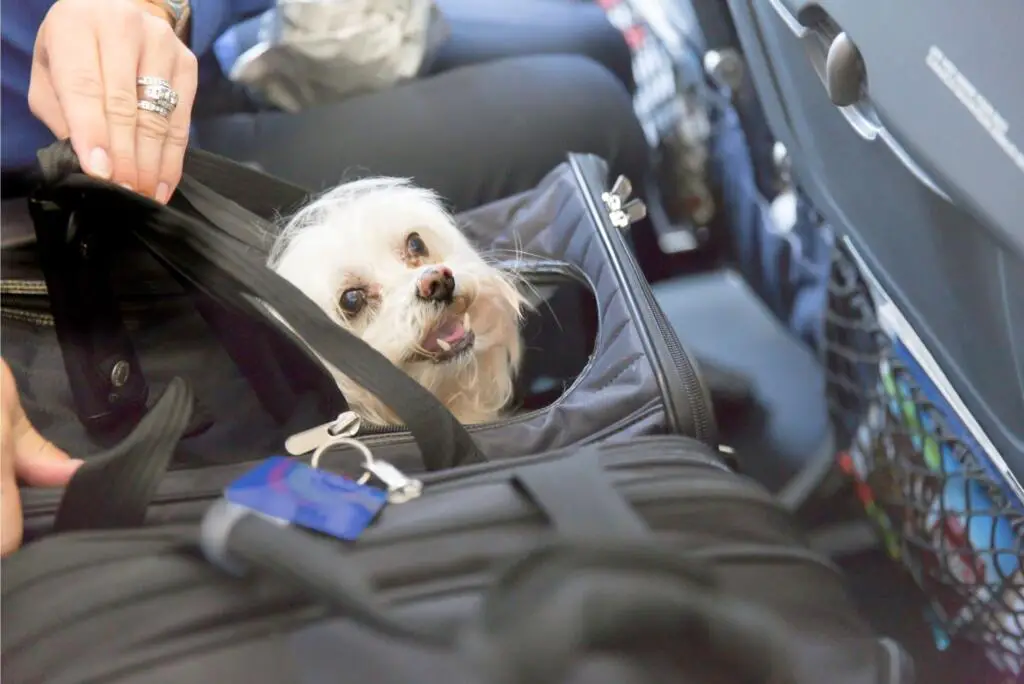Traveling with your dog is something that will likely be a source of stress for both of you. The best way to avoid some of this stress is by preparing properly before the flight. However, besides taking care of basic travel prep beforehand, there are also ways you can make flying with a dog easier.
Article contents
1. Crate train your dog in advance
Dogs that have never been inside a crate before are unlikely to enjoy spending several hours inside it during a flight. To help your dog in keeping its stress levels low, crate training is essential. This will teach your dog to see the crate as a safe place where nothing bad will happen. If you already know you’re likely to need to travel with your pup at some point, start crate training as soon as you adopt it. That way, when the time comes, your dog will be a pro at staying happy and calm inside the crate.
Purchase the crate you’ll be using during the flight way beforehand and use it in your dog’s crate training. While airlines set their own policies on the types of pet crates they accept on flights, The Points Guy has a guide on choosing an on-board pet crate.

2. Double-check airline pet policies
Before booking a flight, be sure to read the airline’s policies on pets and look for information on the types of breeds that are allowed to travel, and size and weight restrictions. Great! Read them again. If needed, call the airline to ensure you won’t have any problems when boarding. You wouldn’t want your dog to be denied to enter the flight because there was a small detail you missed. Don’t assume that you can bring your dog in the cabin on a flight because you’ve done it with anotehr airline before. Even the same airline can change its policies at any point.
3. Give your dog plenty of exercise before flying
The best way to help your dog stay calm during the flight is by giving it plenty of opportunities to exercise beforehand. You’ve probably already heard that “a tired dog is a happy dog” and this is true. If your dog is tired enough it will likely sleep throughout most of the flight. Of course, you should exercise your dog in your daily life but it’s especially important that you take some extra time to walk your dog before leaving for the airport. A good 40-60 minute walk will do the trick and will help your dog keep its stress levels low.
Besides exercising, you should also give your dog an opportunity for a potty break before getting in the crate. Most airports have pet relief areas and you can find lists on your airport website and at Pet Friendly Travel. It’s also a good idea to add some puppy pads to the bottom of the crate just in case there are any accidents.
4. Control food and water intake before the flight
On the departure day, avoid feeding your dog in the morning and restrict water intake two hours before the flight. This will help avoid your dog being sick during the flight and prevent any accidents. Dogs are just fine without water or food for a few hours and this can make a huge difference in how well your dog travels.
If your dog is traveling in the cabin with you, you can ask the flight attendants for an ice cube. That way, your dog can stay hydrated and have something to keep it entertained. But don’t give your dog too much water, save it for when you land.

5. If you’re flying with a dog in the cabin, know what you can and cannot do
If your dog is able to fly in the cabin with you, check what you’re allowed to do and what the procedures are. During take-off and landing will your dog have to in the overhead luggage storage or below the seat in front of you? Will you be able to take your dog out of the carrier during the flight? You may also be able to board earlier and if so, this is a great opportunity for your dog to get comfortable with its surroundings before the flight.
To give your dog some extra comfort, pack a pet blanket to keep it warm and cozy. You can also add one of your t-shirts so that your dog has a familiar smell close during the entire flight. The difference in air pressure can also affect a dog’s ears so give your dog a chew toy during take-off and landing.
Making sense of it all
As a dog owner, you always want to make sure your dog is as comfortable and calm as possible, and following these tips will help you achieve just that when you’re flying with a dog. Keeping your dog calm during the flight is especially important for brachycephalic breeds (short-nosed like pugs or French bulldogs). These breeds are already known for their breathing problems which can easily get worse and become a problem if the dog is stressed.
Flying with a dog isn’t as scary as it may seem, and being well prepared and following these tips will help you have a smooth and successful trip with your pooch.
